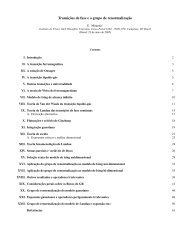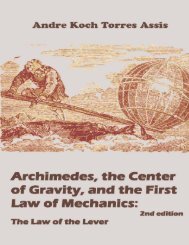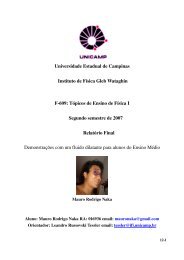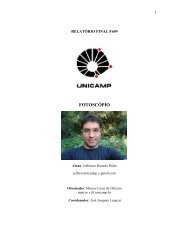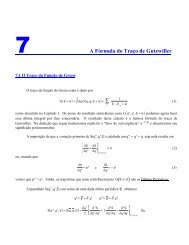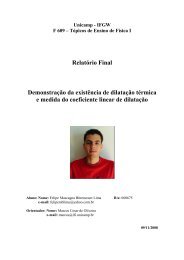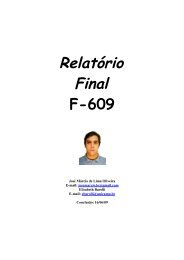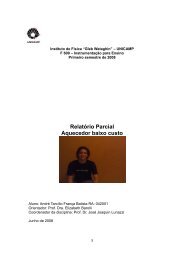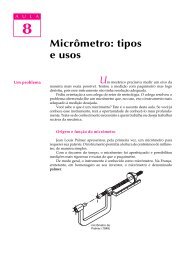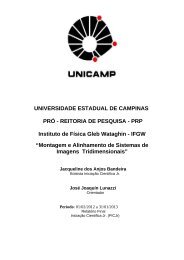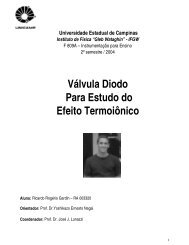- Page 1 and 2: Andre Koch Torres Assis The Experim
- Page 3 and 4: Published by C. Roy Keys Inc. 4405,
- Page 5 and 6: 4.8 The ACR Mechanism . . . . . . .
- Page 7 and 8: Bibliography 259 6
- Page 9 and 10: GGPE—UNICAMP, as well as the rich
- Page 12 and 13: Chapter 1 Introduction One of the g
- Page 14 and 15: even be utilized at a post-graduate
- Page 16 and 17: Chapter 2 Electrification by Fricti
- Page 18 and 19: which does not attract small pieces
- Page 20 and 21: Accordingtosomemodernauthors, theam
- Page 22 and 23: never be rubbed. This will be our n
- Page 24 and 25: Experiment 2.6 Figure 2.5: A rubbed
- Page 26 and 27: I opened the cock, and let the wate
- Page 28 and 29: Or else: 20 Andlikenessisnotthecaus
- Page 30 and 31: (a) (b) F F F F F (c) . F F F F F F
- Page 32: Several words used to this day have
- Page 35 and 36: His instrument was first presented
- Page 37 and 38: Figure 3.3: Gilbert’s versorium.
- Page 39 and 40: in this case a strip of plastic or
- Page 41: with a light mobile part made of a
- Page 45 and 46: Experiment 3.3 We move a neutral st
- Page 47 and 48: circles coinciding with the center
- Page 49 and 50: hour. The experiments indicate that
- Page 51 and 52: The fact that an electrically charg
- Page 53 and 54: Figure 3.20: Robert Boyle (1627-169
- Page 55 and 56: This course of rubbing on the edge
- Page 57 and 58: follows: 21 To every action there i
- Page 59 and 60: hitherto escape observation; and pe
- Page 61 and 62: thread 10 or 20 cm long. The thread
- Page 63 and 64: 4.2 Guericke’s Experiment with a
- Page 65 and 66: It appeared in his book The New (So
- Page 67 and 68: and Roller, Krafft, and Heilbron. 4
- Page 69 and 70: F C FC F (a) F F F (d) F F F C C (b
- Page 71 and 72: to note that Du Fay himself did not
- Page 73 and 74: A very practical support can be mad
- Page 75 and 76: F F F F F F F F F F (a) (b) Figure
- Page 77 and 78: Definitions: We say that in Experim
- Page 79 and 80: At this moment we move the finger s
- Page 81 and 82: Experiment 4.11 We rub a plastic st
- Page 83 and 84: 4.8 The ACR Mechanism In 1733 Du Fa
- Page 85 and 86: Experiment 4.15 We can make the ele
- Page 87 and 88: It is simply a cotton or linen thre
- Page 89 and 90: to 0.5 cm, and the maximum dimensio
- Page 91 and 92: (a) (b) F F F F F F F F F F F F F F
- Page 93 and 94:
Now what farther I have to add, occ
- Page 96 and 97:
Chapter 5 Positive and Negative Cha
- Page 98 and 99:
first neutral pendulum. The pendulu
- Page 100 and 101:
I A PA A SA A A A A II (a) (b) Figu
- Page 102 and 103:
charged pendulum �, without allow
- Page 104 and 105:
straw that has been rubbed with an
- Page 106 and 107:
+ + + - - - + + + - - - (a) (b) (c)
- Page 108 and 109:
[...] It is then certain that bodie
- Page 110 and 111:
I confess I had expected an entirel
- Page 112 and 113:
A very interesting video showing a
- Page 114 and 115:
same happens between a plastic rubb
- Page 116 and 117:
two charged pendulums hang vertical
- Page 118 and 119:
- - - + + + - - - + + + (a) (b) (c)
- Page 120 and 121:
electricity. Initially he built a m
- Page 122 and 123:
charged straws, we can determine th
- Page 124 and 125:
+ hair smooth glass human skin synt
- Page 126 and 127:
now slowly bring our finger near th
- Page 128 and 129:
whichchargeditbycontact. Inthissitu
- Page 130 and 131:
electrified than �, that is, that
- Page 132 and 133:
the level of the thermometer is hig
- Page 134 and 135:
Chapter 6 Conductors and Insulators
- Page 136 and 137:
is to fold the upper strip horizont
- Page 138 and 139:
- - - (a) (b) (c) . Figure 6.5: (a)
- Page 140 and 141:
toward the electroscope and away fr
- Page 142 and 143:
(a) (b) Figure 6.10: Attraction bet
- Page 144 and 145:
Experiment 6.11 We again charge the
- Page 146 and 147:
Experiment 6.13 The procedure descr
- Page 148 and 149:
are conductors, very few are insula
- Page 150 and 151:
Experiment 6.15 The procedure of Ex
- Page 152 and 153:
conductor insulator (a) (b) (c). in
- Page 154 and 155:
second wire is connected to the pos
- Page 156 and 157:
suppose that the light does not tur
- Page 158 and 159:
6.7.1 The Time Necessary in order t
- Page 160 and 161:
pendulum negatively and another one
- Page 162 and 163:
- - - (a) - - - - - - - - - (b) - -
- Page 164 and 165:
(a) (b) Figure 6.32: (a) Electrosco
- Page 166 and 167:
it was prick’d, and the snapping
- Page 168 and 169:
pended by silk cords, presents the
- Page 170 and 171:
Figure 6.36: Nollet’s electromete
- Page 172 and 173:
od �, with a cork ball at the end
- Page 174 and 175:
Chapter 7 Differences between Condu
- Page 176 and 177:
the pendulums and electroscopes als
- Page 178 and 179:
the disk. plastic straw disk of thi
- Page 180 and 181:
all of them placed side by side on
- Page 182 and 183:
- - - - - - - - - - � � � �
- Page 184 and 185:
them side by side along the same pl
- Page 186 and 187:
sides, provided the plate is polari
- Page 188 and 189:
An experiment analogous to Experime
- Page 190 and 191:
(a) (b) Figure 7.17: Two electrosco
- Page 192 and 193:
trically polarized. The edge close
- Page 194 and 195:
it charges a pendulum by the ACR me
- Page 196 and 197:
move the rubbed straw near the cond
- Page 198 and 199:
- - - (a) (b) Figure7.26: (a)Aninsu
- Page 200 and 201:
� � � � � � � � Fig
- Page 202 and 203:
- - - - - - - - - - � � � �
- Page 204 and 205:
to distinguish it from the polarize
- Page 206 and 207:
net negative charge of ��. The
- Page 208 and 209:
of opposite sign attract one anothe
- Page 210 and 211:
Figure 7.38: W. Thomson (Lord Kelvi
- Page 212 and 213:
- - - - - - - - - - - - - - - - - -
- Page 214 and 215:
amber effect, Sections 2.1 and 2.2.
- Page 216 and 217:
Figure 7.44: We strike a match near
- Page 218 and 219:
F F F F F F (a) (b) Figure 7.45: (a
- Page 220 and 221:
Chapter 8 Final Considerations 8.1
- Page 222 and 223:
forces also increases when the stre
- Page 224 and 225:
ordinary experiments involving smal
- Page 226 and 227:
the plastic disk. This polarization
- Page 228 and 229:
The microscopic description of what
- Page 230 and 231:
+ + + + - - - - + - + - --- + - + -
- Page 232 and 233:
Appendix A Definitions Here we pres
- Page 234 and 235:
Appendix B Stephen Gray and the Dis
- Page 236 and 237:
attractive vertue might be carried
- Page 238 and 239:
was attracted and repelled many tim
- Page 240 and 241:
this article: to communicate electr
- Page 242 and 243:
making metals attract light bodies.
- Page 244 and 245:
greatest discovery: 21 As we had no
- Page 246 and 247:
Figure B.9: Gray rubs his 1 m long
- Page 248 and 249:
Grayhadalreadydiscoveredhowtocommun
- Page 250 and 251:
A representation of this experiment
- Page 252 and 253:
March the 23d [of 1730], I dissolve
- Page 254 and 255:
Figure B.19: Illustration of Du Fay
- Page 256 and 257:
estimation, about fourteen or fifte
- Page 258 and 259:
In Section 4.10 we analyzed the beh
- Page 260 and 261:
Bibliography [Aep79] F. U. T. Aepin
- Page 262 and 263:
[Can54] J. Canton. A letter to the
- Page 264 and 265:
[Fer01c] N. C. Ferreira. Magnetismo
- Page 266 and 267:
[Haub] F. Hauksbee. An account of t
- Page 268 and 269:
[Ørs98a] H. C. Ørsted. New electr
- Page 270:
The Experimental and Historical Fou



